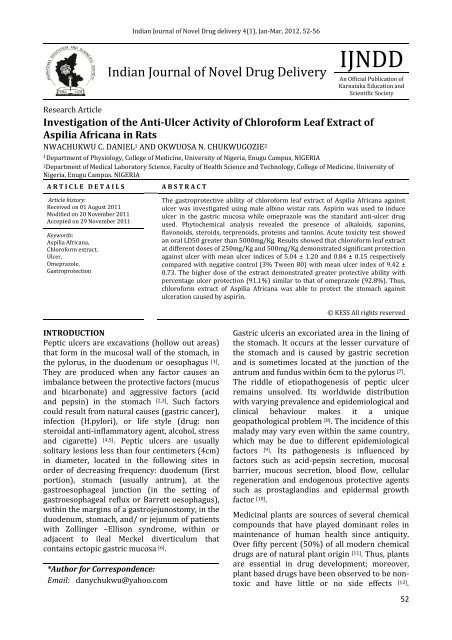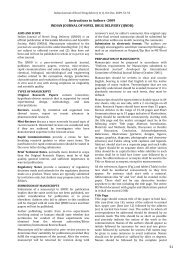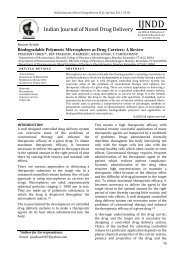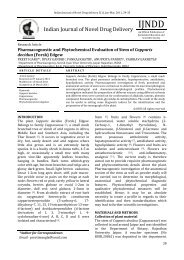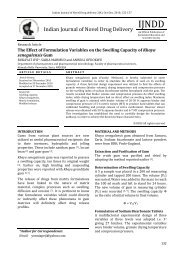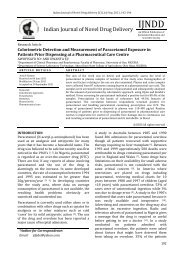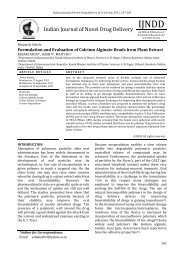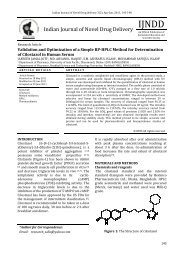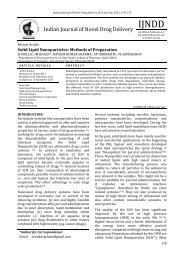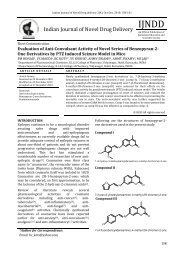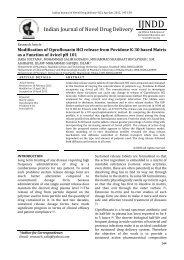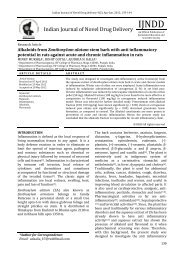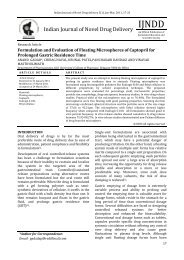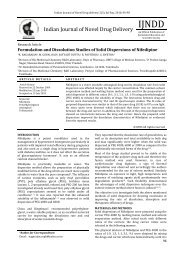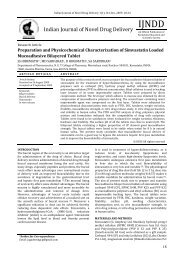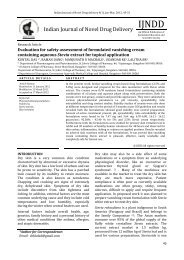Investigation of the Anti-Ulcer Activity of Chloroform Leaf Extract of ...
Investigation of the Anti-Ulcer Activity of Chloroform Leaf Extract of ...
Investigation of the Anti-Ulcer Activity of Chloroform Leaf Extract of ...
You also want an ePaper? Increase the reach of your titles
YUMPU automatically turns print PDFs into web optimized ePapers that Google loves.
Indian Journal <strong>of</strong> Novel Drug delivery 4(1), Jan-Mar, 2012, 52-56<br />
Indian Journal <strong>of</strong> Novel Drug Delivery<br />
IJNDD<br />
An Official Publication <strong>of</strong><br />
Karnataka Education and<br />
Scientific Society<br />
Research Article<br />
<strong>Investigation</strong> <strong>of</strong> <strong>the</strong> <strong>Anti</strong>-<strong>Ulcer</strong> <strong>Activity</strong> <strong>of</strong> Chlor<strong>of</strong>orm <strong>Leaf</strong> <strong>Extract</strong> <strong>of</strong><br />
Aspilia Africana in Rats<br />
NWACHUKWU C. DANIEL 1 AND OKWUOSA N. CHUKWUGOZIE 2<br />
1 Department <strong>of</strong> Physiology, College <strong>of</strong> Medicine, University <strong>of</strong> Nigeria, Enugu Campus, NIGERIA<br />
2Department <strong>of</strong> Medical Laboratory Science, Faculty <strong>of</strong> Health Science and Technology, College <strong>of</strong> Medicine, University <strong>of</strong><br />
Nigeria, Enugu Campus. NIGERIA<br />
A R T I C L E D E T A I L S<br />
A B S T R A C T<br />
Article history:<br />
Received on 01 August 2011<br />
Modified on 20 November 2011<br />
Accepted on 29 November 2011<br />
Keywords:<br />
Aspilia Africana,<br />
Chlor<strong>of</strong>orm extract,<br />
<strong>Ulcer</strong>,<br />
Omeprazole,<br />
Gastroprotection<br />
The gastroprotective ability <strong>of</strong> chlor<strong>of</strong>orm leaf extract <strong>of</strong> Aspilia Africana against<br />
ulcer was investigated using male albino wistar rats. Aspirin was used to induce<br />
ulcer in <strong>the</strong> gastric mucosa while omeprazole was <strong>the</strong> standard anti-ulcer drug<br />
used. Phytochemical analysis revealed <strong>the</strong> presence <strong>of</strong> alkaloids, saponins,<br />
flavonoids, steroids, terprenoids, proteins and tannins. Acute toxicity test showed<br />
an oral LD50 greater than 5000mg/Kg. Results showed that chlor<strong>of</strong>orm leaf extract<br />
at different doses <strong>of</strong> 250mg/Kg and 500mg/Kg demonstrated significant protection<br />
against ulcer with mean ulcer indices <strong>of</strong> 5.04 ± 1.20 and 0.84 ± 0.15 respectively<br />
compared with negative control (3% Tween 80) with mean ulcer index <strong>of</strong> 9.42 ±<br />
0.73. The higher dose <strong>of</strong> <strong>the</strong> extract demonstrated greater protective ability with<br />
percentage ulcer protection (91.1%) similar to that <strong>of</strong> omeprazole (92.8%). Thus,<br />
chlor<strong>of</strong>orm extract <strong>of</strong> Aspilia Africana was able to protect <strong>the</strong> stomach against<br />
ulceration caused by aspirin.<br />
© KESS All rights reserved<br />
INTRODUCTION<br />
Peptic ulcers are excavations (hollow out areas)<br />
that form in <strong>the</strong> mucosal wall <strong>of</strong> <strong>the</strong> stomach, in<br />
<strong>the</strong> pylorus, in <strong>the</strong> duodenum or oesophagus [1] .<br />
They are produced when any factor causes an<br />
imbalance between <strong>the</strong> protective factors (mucus<br />
and bicarbonate) and aggressive factors (acid<br />
and pepsin) in <strong>the</strong> stomach [2,3] . Such factors<br />
could result from natural causes (gastric cancer),<br />
infection (H.pylori), or life style (drug: non<br />
steroidal anti-inflammatory agent, alcohol, stress<br />
and cigarette) [4,5]. Peptic ulcers are usually<br />
solitary lesions less than four centimeters (4cm)<br />
in diameter, located in <strong>the</strong> following sites in<br />
order <strong>of</strong> decreasing frequency: duodenum (first<br />
portion), stomach (usually antrum), at <strong>the</strong><br />
gastroesophageal junction (in <strong>the</strong> setting <strong>of</strong><br />
gastroesophageal reflux or Barrett oesophagus),<br />
within <strong>the</strong> margins <strong>of</strong> a gastrojejunostomy, in <strong>the</strong><br />
duodenum, stomach, and/ or jejunum <strong>of</strong> patients<br />
with Zollinger –Ellison syndrome, within or<br />
adjacent to ileal Meckel diverticulum that<br />
contains ectopic gastric mucosa [6] .<br />
*Author for Correspondence:<br />
Email: danychukwu@yahoo.com<br />
Gastric ulceris an excoriated area in <strong>the</strong> lining <strong>of</strong><br />
<strong>the</strong> stomach. It occurs at <strong>the</strong> lesser curvature <strong>of</strong><br />
<strong>the</strong> stomach and is caused by gastric secretion<br />
and is sometimes located at <strong>the</strong> junction <strong>of</strong> <strong>the</strong><br />
antrum and fundus within 6cm to <strong>the</strong> pylorus [7] .<br />
The riddle <strong>of</strong> etiopathogenesis <strong>of</strong> peptic ulcer<br />
remains unsolved. Its worldwide distribution<br />
with varying prevalence and epidemiological and<br />
clinical behaviour makes it a unique<br />
geopathological problem [8] . The incidence <strong>of</strong> this<br />
malady may vary even within <strong>the</strong> same country,<br />
which may be due to different epidemiological<br />
factors [9]. Its pathogenesis is influenced by<br />
factors such as acid-pepsin secretion, mucosal<br />
barrier, mucous secretion, blood flow, cellular<br />
regeneration and endogenous protective agents<br />
such as prostaglandins and epidermal growth<br />
factor [10] .<br />
Medicinal plants are sources <strong>of</strong> several chemical<br />
compounds that have played dominant roles in<br />
maintenance <strong>of</strong> human health since antiquity.<br />
Over fifty percent (50%) <strong>of</strong> all modern chemical<br />
drugs are <strong>of</strong> natural plant origin [11] . Thus, plants<br />
are essential in drug development; moreover,<br />
plant based drugs have been observed to be nontoxic<br />
and have little or no side effects [12].<br />
52
Nwachukwu C. Daniel et al / Indian Journal <strong>of</strong> Novel Drug Delivery 4(1), Jan-Mar, 2012, 52-56<br />
<strong>Extract</strong>s from <strong>the</strong> leaves, seeds, fruits, barks and<br />
roots <strong>of</strong> medicinal plants have been used in <strong>the</strong><br />
preparation <strong>of</strong> infusions in traditional medicine.<br />
These infusions have been used to treat ailments<br />
ranging from common cold to malaria, liver<br />
cirrhosis, hypertension and so on. The active<br />
constituents contributing to <strong>the</strong> protective<br />
effects are <strong>the</strong> phytochemicals, vitamins and<br />
minerals [13] . One <strong>of</strong> such medicinal plants is<br />
Aspilia africana which has a folk line reputation<br />
as an anti ulcer remedy.<br />
Aspilia africana is a perennial herb varying in<br />
height from 60cm to about 1.5m depending on<br />
rainfall. It is a common weed <strong>of</strong> field crops in<br />
West Africa and sometimes found in fallow land<br />
especially <strong>the</strong> forest zones [14] . In Nigeria, it is<br />
variously known as “Oranjila” in Igbo, “Tozalin”<br />
in Hausa, “Yunyun” in Yoruba and “Edemedong”<br />
in Efik [15] . The plant is a weed grazed by cattle<br />
and sheep and is mostly used in <strong>the</strong> South-West,<br />
Nigeria, as food for rabbits and hares [16] . Aspilia<br />
africana is widely used in African folk medicine<br />
to stop bleeding, remove corneal opacities,<br />
induce delivery and in <strong>the</strong> treatment <strong>of</strong> anaemia<br />
and various stomachs complains. Infusion <strong>of</strong> <strong>the</strong><br />
leaves is taken by children and can also be mixed<br />
with clay as a medicine for stomach trouble [17] . It<br />
has been reported that <strong>the</strong> plant is effective<br />
against malaria infection [18] . The plant has been<br />
reported to possess anti-microbial [19] and antihaemostatic,<br />
antifertility [20] and antiinflammatory<br />
activity [21] .<br />
Its phytochemical analysis revealed that it is rich<br />
in flavonoids, saponin, tannins, alkaloid, sterols,<br />
terpens. The medicinal plant also contains<br />
vitamins: ascorbic acid, rib<strong>of</strong>lavin, thiamine, and<br />
niacin [17] .<br />
Allopathic drugs have been used to treat or<br />
manage gastric ulcer. Some <strong>of</strong> <strong>the</strong>se agents like<br />
proton pump inhibitors (e.g. esomeprazole,<br />
omeprazole), H2-receptor antagonists e.g.<br />
cimetidine have side effects and <strong>the</strong>re is a high<br />
incidence <strong>of</strong> ulcer relapse and drug interaction<br />
following <strong>the</strong> use <strong>of</strong> <strong>the</strong>se drug [22, 23] . Therefore,<br />
<strong>the</strong>re is need to evaluate medicinal plants with<br />
potential antiulcer properties since plant based<br />
drugs have been observed to be non-toxic and<br />
have little or no side effects12. The search has<br />
yielded good results as <strong>the</strong> antiulcer activity <strong>of</strong><br />
some medicinal plants has been scientifically<br />
validated [24-27]. Moreover, pharmacoeconomic<br />
considerations make it impossible for patients in<br />
low socioeconomic background to afford <strong>the</strong>se<br />
allopathic drugs. Consequently, <strong>the</strong>re is tendency<br />
to seek traditional medical care. We, <strong>the</strong>refore,<br />
decided to embark on this study in order to<br />
evaluate <strong>the</strong> gastroprotective activity <strong>of</strong> leaf<br />
extract <strong>of</strong> Aspilia Africana in experimentally<br />
induced gastric ulcer and contribute <strong>the</strong> on-going<br />
effort aimed at providing cheaper and better<br />
remedy for this disease.<br />
MATERIALS AND METHODS<br />
Animals<br />
Thirty-three male albino wistar rats weighing<br />
160-240g were used for <strong>the</strong> study. They were<br />
procured from <strong>the</strong> animal house, Department <strong>of</strong><br />
Physiology, College <strong>of</strong> Medicine, University <strong>of</strong><br />
Nigeria, Enugu Campus. The rats were kept in <strong>the</strong><br />
same environment under standard temperature<br />
condition (28±3 0 C) with12:12 hour light/dark<br />
cycle. They were fed with commercial grower’s<br />
feed (Guinea feed®Nig. PLC) and had free access<br />
to clean drinking water.<br />
Plant Materials<br />
Leaves <strong>of</strong> Aspilia Africana were collected from<br />
<strong>the</strong> premises <strong>of</strong> University <strong>of</strong> Nigeria, Nsukka and<br />
au<strong>the</strong>nticated by a taxonomist at <strong>the</strong> herbarium<br />
section <strong>of</strong> Department <strong>of</strong> Botany, University <strong>of</strong><br />
Nigeria. A voucher specimen with number<br />
UNH/315c was kept in <strong>the</strong> herbarium for future<br />
references. The leaves were dried under shade<br />
and milled using an electric blender.<br />
<strong>Extract</strong> Preparation<br />
1000g <strong>of</strong> powdered leaves <strong>of</strong> Aspilia Africana<br />
were soaked in 3 litres <strong>of</strong> chlor<strong>of</strong>orm for 72hours<br />
and strained with muslin cloth, <strong>the</strong>n filtered<br />
using Whatman no. 1 filter paper. The filtrate<br />
was allowed to dry in open air and a dark<br />
greenish extract was formed. 20g <strong>of</strong> <strong>the</strong> extract<br />
was dissolved in 10ml <strong>of</strong> 3% Tween 80 and made<br />
up to 100ml with chlor<strong>of</strong>orm.<br />
Phytochemical Analysis<br />
Phytochemical screening was carried out using<br />
<strong>the</strong> method <strong>of</strong> Trease and Evans [28] . This method<br />
is useful in determine <strong>the</strong> various constituents <strong>of</strong><br />
<strong>the</strong> plant and <strong>the</strong>ir pharmacological and<br />
toxicological effects [29] .<br />
Acute Toxicity Test<br />
13 male albino wistar rats were used for<br />
determination <strong>of</strong> LD50 as described by Lorke [30] .<br />
Aspirin induced ulceration<br />
20 male albino wistar rats were divided into four<br />
groups (A-D) <strong>of</strong> 5 rats each. The rats were<br />
starved for 24 hours prior to <strong>the</strong> commencement<br />
53
Nwachukwu C. Daniel et al / Indian Journal <strong>of</strong> Novel Drug Delivery 4(1), Jan-Mar, 2012, 52-56<br />
<strong>of</strong> <strong>the</strong> experiment but had free access to clean<br />
water. 250mg/Kg <strong>of</strong> Chlor<strong>of</strong>orm extract (CE) was<br />
given to rats in group A; 500mg/Kg was given to<br />
rats in group B while those in group C were given<br />
20mg/Kg <strong>of</strong> omeprazole. Group D served as <strong>the</strong><br />
negative control and rats in this group were<br />
given 5ml/Kg <strong>of</strong> 3% Tween 80. All<br />
administration was via oral route using gavage.<br />
Thirty minutes after administration, 200mg/Kg<br />
<strong>of</strong> aspirin were given orally to all <strong>the</strong> rats in<br />
every group. The animals were euthanized after<br />
4 hours, <strong>the</strong>ir stomach removed, cut open<br />
through <strong>the</strong> greater curvature and <strong>the</strong>n washed<br />
in normal saline. Their stomach were spread and<br />
pinned flat on a plywood using thumb-tacks.<br />
With <strong>the</strong> aid <strong>of</strong> a hand lens, <strong>the</strong>ir stomach were<br />
observed for ulcers and scored as described by<br />
Main and Whittle [31] as follows:<br />
1mm 2mm 0.05) when compared to that <strong>of</strong> omeprazole,<br />
in fact, both groups showed similar protective<br />
potency against ulcer (Table 2).<br />
Table 1: Phytochemical Analysis <strong>of</strong> Aspilia Africana<br />
Sl/No Phytochemical Degree <strong>of</strong><br />
presence<br />
1 Alkaloids +++<br />
2 Flavonoids +++<br />
3 Fats and Oil -<br />
4 Reducing sugar +<br />
5 Saponins +++<br />
6 Tannins +<br />
7 Terprenoids ++<br />
8 Proteins +++<br />
9 Polysaccharides +++<br />
10 Steroids ++<br />
11 Cardiac glycosides +<br />
12 Phlobatanins +<br />
- Absent<br />
+ Present in small concentration<br />
++ Moderately high concentration<br />
+++ Very high concentration<br />
Result <strong>of</strong> acute toxicity study showed an oral<br />
LD 50 greater than 5000mg/Kg<br />
Table 2: Comparison <strong>of</strong> <strong>the</strong> ulcer indices in<br />
treatment groups with control groups<br />
Groups<br />
<strong>Ulcer</strong> index<br />
Mean ± SEM<br />
A (250mg/Kg) CEAA 5.04 ± 1.02 a,c 46.5<br />
B (500mg/Kg) CEAA 0.84 ± 0.15 b,d 91.1<br />
C (20mg/Kg) Omeprazole 0.68 ± 0.15 b 92.8<br />
D (5ml/Kg <strong>of</strong> 3% Tween 80) 9.42 ± 0.73 -<br />
% <strong>Ulcer</strong><br />
protection<br />
DISCUSSION<br />
We evaluated <strong>the</strong> antiulcer activity <strong>of</strong> chlor<strong>of</strong>orm<br />
extract <strong>of</strong> leaves <strong>of</strong> Aspilia Africana against<br />
aspirin induced ulceration. Phytochemical<br />
analysis and acute toxicity study were also<br />
carried out. An oral LD50 is greater than<br />
5000mg/Kg indicates that <strong>the</strong> extract is safe.<br />
Aspirin is a weak organic acid that reversibly<br />
inactivates cycloxygenase (COX I) required for<br />
<strong>the</strong> syn<strong>the</strong>sis <strong>of</strong> prostaglandins. This inhibits<br />
gastric cytoprotective action <strong>of</strong> prostaglandins<br />
[33]. Ano<strong>the</strong>r possible mechanism <strong>of</strong> ulcer<br />
induction by aspirin is by <strong>the</strong> process <strong>of</strong> ‘ion<br />
trapping’. Aspirin (pKa 3.5) becomes ionized and<br />
non-diffusible on entering mucosal cells (pH 7.1)<br />
causing focal necrosis <strong>of</strong> <strong>the</strong> cells, acute ulcers<br />
and microscopic haemorrhage [23] . Aspirin may<br />
also cause inhibition <strong>of</strong> gastric mucous secretion<br />
and mucosal blood flow [34] .<br />
54
Nwachukwu C. Daniel et al / Indian Journal <strong>of</strong> Novel Drug Delivery 4(1), Jan-Mar, 2012, 52-56<br />
Omeprazole is a proton pump inhibitor which<br />
forms a covalent disulphide bond with H+- K+<br />
ATPase (proton pump) and irreversibly<br />
inactivates <strong>the</strong> enzyme, thus blocking <strong>the</strong> final<br />
common pathway for acid secretion [35].<br />
Omeprazole also has anti-secretory and antiulcer<br />
effects [3] .<br />
Chlor<strong>of</strong>orm leaf extract <strong>of</strong> Aspilia Africana<br />
demonstrated gastroprotective activity against<br />
ulcer induced by aspirin in a dose-dependent<br />
manner; <strong>the</strong> higher dose <strong>of</strong> <strong>the</strong> extract<br />
(500mg/Kg) showed similar potency as<br />
omeprazole. The protection effect <strong>of</strong> <strong>the</strong> extract<br />
may be due its high content <strong>of</strong> flavonoids,<br />
alkaloids and saponins, phytochemicals that have<br />
demonstrated strong antioxidant properties [36] .<br />
Flavonoids are potent water soluble antioxidants<br />
and free radical scavengers which prevent<br />
oxidative cell damage and ulceration [36-38].<br />
Flavonoids also prevent gastric mucosal lesion<br />
and was identified as <strong>the</strong> most important plant<br />
constituents associated with anti-ulcer activity<br />
[39]. Flavonoids also possess anti-inflammatory<br />
activity [37] . Thus, <strong>the</strong> presence <strong>of</strong> large amount <strong>of</strong><br />
flavonoids in Aspilia Africana may justify its use<br />
in folk medicine for <strong>the</strong> treatment <strong>of</strong> ulcers,<br />
wounds and burns. Flavonoids, Saponins and<br />
tannins were reported to possess antiulcerogenic<br />
and anti-gastric activity [40, 41].<br />
Therefore, <strong>the</strong> presence <strong>of</strong> <strong>the</strong>se <strong>of</strong> <strong>the</strong>se<br />
compounds in <strong>the</strong> extract may be responsible for<br />
<strong>the</strong> observed anti-ulcer activity.<br />
CONCLUSION<br />
The leaf extract <strong>of</strong> Aspilia Africana demonstrated<br />
considerable anti-ulcer activity comparable to<br />
that <strong>of</strong> omeprazole in aspirin induced ulceration<br />
in rats. This action may be due to its<br />
phytochemical constituents especially<br />
flavonoids.<br />
REFERENCES<br />
[1] Adreoli T, Chan PD, Cowell JC, Gilbert DM,<br />
Green G, Johnson M. et al. Management <strong>of</strong><br />
patients with Gastric and Duodenal<br />
disorders In Brunner and Suddarth’s<br />
Textbook <strong>of</strong> Medical Nursing. 11th edition,<br />
Elsevier, Philaldephia, USA. pp 1203-1279;<br />
2008.<br />
[2] Ojewole EB. Peptic ulcer disease. In<br />
Therapeutic Basis <strong>of</strong> clinical pharmacy in<br />
<strong>the</strong> tropics. 3rd edition, SNAAP press,<br />
Enugu, Nigeria. pp 541-564; 2004.<br />
[3] Del Valle J, Cheg W, Scherman J. Acid Peptic<br />
Disorder in Textbook <strong>of</strong> gastroenteroloy.<br />
4th edition,Philaldephia, Lippincott<br />
William and Wilkins pp: 1321-1376; 2003.<br />
[4] Berandi RR, Welage S. Peptic <strong>Ulcer</strong> Disease<br />
In Pharmaco<strong>the</strong>rapy: A pathophysiologic<br />
approach. 6th edition McGraw-Hill pp: 629-<br />
648; 2005.<br />
[5] Suerbaum S, Michetti P. Helicobacter<br />
pylori infection. New English Journal <strong>of</strong><br />
Medicine 2002; 347: 1175-1186.<br />
[6] Chan FK, Leung WK. Peptic ulcer disease.<br />
Lancet 2002; 360: 933-939<br />
[7] Ojewole EB. Peptic ulcer disease In:<br />
Therapeutic basis <strong>of</strong> clinical pharmacy in<br />
<strong>the</strong> tropic. 2nd edition, optimal publishers<br />
Enugu, Nigeria. Pp 401-437; 1996.<br />
[8] Watkins G. Geographical aspects <strong>of</strong> peptic<br />
ulcer. Modern trends in Gastroenterology,<br />
third edition by W.L. Card Butterworths,<br />
London; 1961.<br />
[9] Dogra JR. Studies on peptic ulcer in South<br />
India, part I: Introduction and Clinical<br />
study <strong>of</strong> 258 cases. Indian JL Med. Res.<br />
1940; 28:145.<br />
[10] Hadey GG. A study <strong>of</strong> peptic ulcer as found<br />
in South India: In proceedings <strong>of</strong> <strong>the</strong> group<br />
discussion on peptic ulcer, p 31, I.C.M.R.<br />
Publication, New Delhi, India; 1959.<br />
[11] Burton GW, Joyce D, Ingolk KU. Is vitamin<br />
E <strong>the</strong> only lipid soluble chain having<br />
antioxidant activity in human blood,<br />
plasma and erythrocyte? Archives <strong>of</strong><br />
Biochemistry and Biophsiology. 1993; 222:<br />
228-232.<br />
[12] Momin A. Role <strong>of</strong> indigenous medicine in<br />
primary health care. 1st International<br />
Seminar on Unani Medicine, New Delhi,<br />
India. 1987; p 54.<br />
[13] Okwu DE, Ekeke O. Phytochemical<br />
Screening and Mineral Composition <strong>of</strong><br />
Chewing Sticks in South eastern Nigeria.<br />
Global Journal <strong>of</strong> Pure and Applied Sciences<br />
2003; 9: 235-238.<br />
[14] Eweka AO. Histological Studies <strong>of</strong> <strong>the</strong><br />
effect <strong>of</strong> Oral administration <strong>of</strong> Aspilia<br />
africana (Asteraceae) leaf extract on<br />
Ovaries <strong>of</strong> female Wistar rats. African<br />
Journal <strong>of</strong> Traditional Complementary and<br />
Alternative Medicine. 2009; 6(1): 57-61.<br />
[15] Singha SC. Medicinal Plants <strong>of</strong> Nigeria.<br />
National Press, Lagos pp: 24-30; 1965.<br />
[16] Burkill HM. The useful plants <strong>of</strong> West<br />
Africa. African Royal Botanical Garden<br />
1985; 1: 446-447.<br />
[17] Okwu DE, Josiah C. Evaluation <strong>of</strong> <strong>the</strong><br />
chemical composition <strong>of</strong> two Nigerian<br />
55
Nwachukwu C. Daniel et al / Indian Journal <strong>of</strong> Novel Drug Delivery 4(1), Jan-Mar, 2012, 52-56<br />
medicinal plants. African Journal <strong>of</strong><br />
Biotechnology 2006; 5(4): 357-361.<br />
[18] Okokon JE, Nwidu LI, Essiet GA. (2006).<br />
Evaluation <strong>of</strong> in vivo <strong>Anti</strong>plasmodial<br />
<strong>Activity</strong> <strong>of</strong> Aspilia africana. International<br />
Journal <strong>of</strong> Pharmacology 2006; 2(3): 348-<br />
351.<br />
[19] Macfoy CA, Cline EI. In vitro antibacterial<br />
activities <strong>of</strong> three plants used in traditional<br />
medicine in Sierra Leone. Journal <strong>of</strong><br />
ethnopharmacology 1990; 28: 323-327.<br />
[20] Eweka A. Histological Studies <strong>of</strong> <strong>the</strong> effect<br />
<strong>of</strong> Oral administration <strong>of</strong> Aspilia africana<br />
(Asteraceae) leaf extract on Ovaries <strong>of</strong><br />
female Wistar rats. Internet Journal <strong>of</strong><br />
Alternative Medicine. 2007; 4(2): 120-124.<br />
[21] Okoli CO, Akah P, Okoli A. Potential <strong>of</strong><br />
leaves <strong>of</strong> Aspilia africana (Composite) in<br />
wound care: an experimental evaluation.<br />
Boimedical Centre Complimentary and<br />
Alternative Medicine. 2007; 7(24): 101-<br />
109.<br />
[22] Dharmani P, Palit G. Exploring Indian<br />
medicinal plants for antiulcer activity.<br />
Indian Journal <strong>of</strong> Pharmacology 2006; 38:<br />
95-99.<br />
[23] Tripathi RD. "Drugs for Peptic <strong>Ulcer</strong>",<br />
Essenticals <strong>of</strong> Medical Pharmacology. 6th<br />
edition, Jaypee Bro<strong>the</strong>rs Medical Publisher<br />
Ltd New Delhi, India pp: 627-636; 2005.<br />
[24] Garg GP, Nigam SS, Ogle CW. The gastric<br />
antiulcer effect <strong>of</strong> <strong>the</strong> leaves <strong>of</strong> Neem tree.<br />
Planta Medica. 1993; 59: 215-217.<br />
[25] Anoop A, Jegadeesan M. Studies on <strong>the</strong><br />
antiulcerogenic potential <strong>of</strong> Hemidesmus<br />
indicus. Journal <strong>of</strong> Ethnopharmacology<br />
2003; 84: 149-156.<br />
[26] Okwuosa CN, Unekwe PC, Nwobodo EW,<br />
Chilaka K. The antiulcer activities <strong>of</strong> <strong>the</strong><br />
<strong>Leaf</strong> extracts <strong>of</strong> Combretum racemoum.<br />
Journal <strong>of</strong> Biomedical <strong>Investigation</strong> 2006;<br />
4(1): 8-14.<br />
[27] Al-m<strong>of</strong>leh IA, Al-haider AA, Mossa JS, Alsohaibai<br />
MO, Al-yahya MA, Rafatullah S. et<br />
al. Gastroprotective effect <strong>of</strong> Nigella sativa<br />
on necrotising agent induced gastric injury<br />
in experimental animals. Saudi Journal <strong>of</strong><br />
Gastroenterology 2008; 14(30): 128-134<br />
[28] Trease GE, Evans WC. Textbook <strong>of</strong><br />
pharmacognosy. 12th edition, Balliese<br />
Tindall and Company Publisher, London.<br />
pp 343-383; 1983.<br />
[29] Edeoga HO, Okwu DE, Mbaebie BO.<br />
Phytochemical constituents <strong>of</strong> some<br />
Nigerian Medicial Plants. African Journal <strong>of</strong><br />
Biotechnology 2005; 4(7): 685-688.<br />
[30] Lorke D. New approach to practical acute<br />
toxicity. Archives <strong>of</strong> Toxicology 1983; 54:<br />
275-287.<br />
[31] Main G, Whittle NB. <strong>Investigation</strong> <strong>of</strong><br />
vasodilator and antisecretor role <strong>of</strong><br />
prostaglandin in <strong>the</strong> rat mucosa by use <strong>of</strong><br />
NSAIDs. British Pharmacology 1975; 53:<br />
217-224.<br />
[32] Suzuki Y, Hamagani M, Ito M, Yamagani T.<br />
<strong>Anti</strong>-ulcer effect <strong>of</strong> cetraxate on various<br />
experimental gastric ulcers in rats.<br />
Japanese Journal <strong>of</strong> Pharmacology 1976;<br />
26: 471-474.<br />
[33] Harvey RA, Champe PC, Finkel R, Cubedu<br />
LX, Clark M.A. “<strong>Anti</strong>-inflammatory drugs<br />
and autocoids” Lippincott’s illustrated<br />
reviews: pharmachology. 4th edition,<br />
Lippincott Williams and Wilkins Pp 500-<br />
518; 2009.<br />
[34] Wang GZ, Huang GP, Zhou G, Yin GL, Guo<br />
CJ, Xie CG, et al. Aspirin can elicit <strong>the</strong><br />
occurrence <strong>of</strong> gastric ulcer induced with<br />
acetic acid in rats. Cell Physiol. Biochem.<br />
2007; 20(1-4): 205- 212.<br />
[35] McQuid RK. Drugs used in treatment <strong>of</strong><br />
gastrointestinal diseases In Basic and<br />
Clinical Pharmacology. 11th edition,<br />
McGraw-Hill companies New York, USA pp<br />
1068-1098; 2009.<br />
[36] Salah N, Miller NJ, Payange G, Bolwell GP,<br />
Rice E, Evans C. Polyphenol flavonoids as<br />
scavenger <strong>of</strong> aqueous phase radicals as<br />
chain breaking antioxidant. Archives <strong>of</strong><br />
Biochemistry and Biophsiology. 1995;<br />
[37] Okwu DE. Phytochemicals and Vitamin<br />
content <strong>of</strong> indigenous species <strong>of</strong> South-<br />
Eastern Nigeria. Journal <strong>of</strong> Sustainable<br />
Agriculture and Environment. 2004;<br />
6(1):30-37.<br />
[38] Del Rio A, Obudulu BG, Casfillo J, Marin FG,<br />
Ortuno A. Use and prosperties <strong>of</strong> citrus<br />
flavonoids. Journal <strong>of</strong> Agricultural food<br />
Chemistry. 1997; 45: 4505-4515.<br />
[39] Martin MJ, Motilva V, Alarcon de la lastra C.<br />
Quecertin and naringenin effect <strong>of</strong> ulcer<br />
formation and gastric secretion in rats.<br />
Phyto<strong>the</strong>rapy Research. 1993; 7: 150-153.<br />
[40] Carlo GD, Mascolo N, Capasso F, Autore G.<br />
Effect <strong>of</strong> quercetin on gastrointestinal tract<br />
<strong>of</strong> rats and mice. Phto<strong>the</strong>rapy research<br />
1994; 8: 179-185.<br />
[41] Aguwa CN, Ukwe C. Gastrointestinal<br />
activities <strong>of</strong> Steculia tragacantha leaf<br />
extracts. Fitoterapia. 1997; 68(2): 127-131<br />
56


